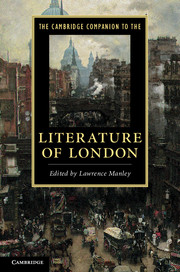Book contents
- Frontmatter
- Introduction
- 1 Images of London in medieval English literature
- 2 London and the early modern stage
- 3 London and the early modern book
- 4 London and poetry to 1750
- 5 Staging London in the Restoration and eighteenth century
- 6 London and narration in the long eighteenth century
- 7 London and nineteenth-century poetry
- 8 London in the Victorian novel
- 9 London in Victorian visual culture
- 10 London in poetry since 1900
- 11 London and modern prose, 1900-1950
- 12 Immigration and postwar London literature
- 13 Writing London in the twenty-first century
- 14 Inner London
- Guide to further reading
- Index
11 - London and modern prose, 1900-1950
Published online by Cambridge University Press: 28 September 2011
- Frontmatter
- Introduction
- 1 Images of London in medieval English literature
- 2 London and the early modern stage
- 3 London and the early modern book
- 4 London and poetry to 1750
- 5 Staging London in the Restoration and eighteenth century
- 6 London and narration in the long eighteenth century
- 7 London and nineteenth-century poetry
- 8 London in the Victorian novel
- 9 London in Victorian visual culture
- 10 London in poetry since 1900
- 11 London and modern prose, 1900-1950
- 12 Immigration and postwar London literature
- 13 Writing London in the twenty-first century
- 14 Inner London
- Guide to further reading
- Index
Summary
Having completed five books of city exploration in the 1920s, each with 'London' in the title, the journalist H. V. Morton went out In Search of England (1927). He started from the capital again - but now with a realisation: 'no man living has seen London'. This was because there was no single vantage-point over the modern metropolis, but also - implicitly and more interestingly - because the city was a myriad of conflicting impressions that could not be unified. Ford Madox Ford had made a similar point in his The Soul of London (1905). His introduction carries a disavowal of the systematic: 'I have tried to make it anything rather than encyclopaedic, topographical, or archaeological'; his tour of London proceeds instead through impressionistic detail. The accretion of textured observations and anecdote is set against the fear of entropic anonymity, of modern London as unknowable: 'how little of a town, how much of an abstraction'. This tendency in both writers – one a blunt, bestselling populist, one a key force in British literary experimentation – is characteristic of many others across genres; it also marks the fault line between twentieth-century London writing and its predecessors, for while Victorian London could be infinitely rich, bewildering, and despair-inducing it was, ultimately, knowable through texts. This was not the case for the literature of modernity; it rather faced simultaneously acknowledging the importance and apparent impossibility of depicting, and thus understanding, modern London.
- Type
- Chapter
- Information
- The Cambridge Companion to the Literature of London , pp. 201 - 221Publisher: Cambridge University PressPrint publication year: 2011
- 1
- Cited by

